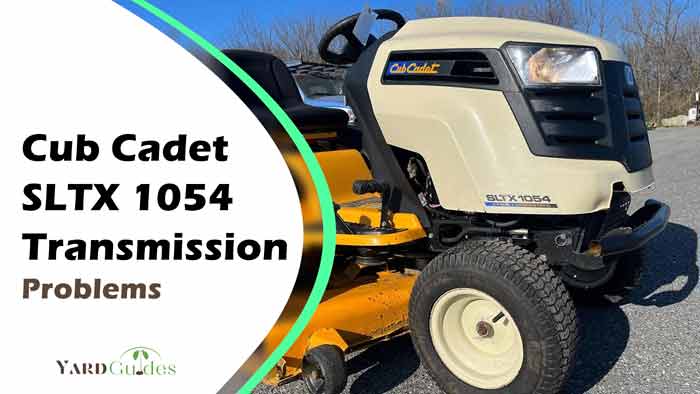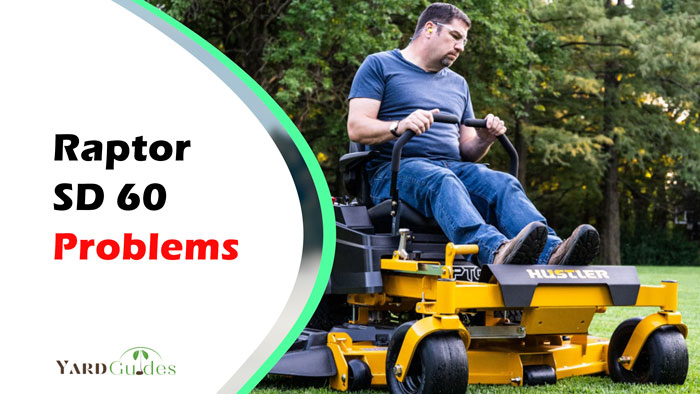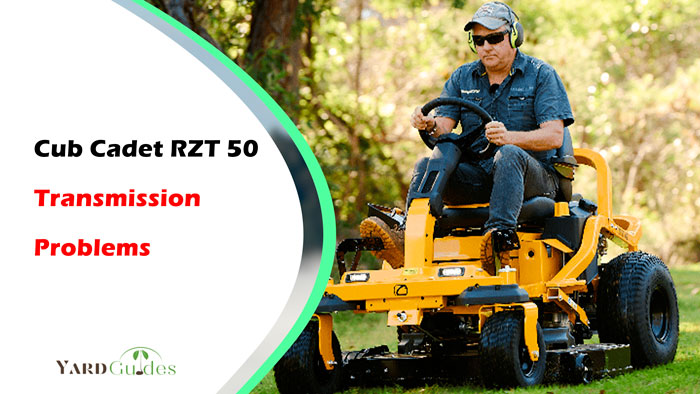The Cub Cadet SLTX 1054 has a powerful engine, comfortable seat, and ample storage space. However, despite its many great features, it has issues with its transmission.
So, what are the common Cub Cadet SLTX 1054 transmission problems? The most common problem is a slipping transmission. The mower may also fail to shift gears or move forward or backward. Other problems include slipping or jerky driving motion, transmission leaks, and clanking noises.
We know you want to return to maintaining your lawn, so we have the solutions to these common transmission problems below. Keep reading to know the issues and how to diagnose, troubleshoot, and fix them.
Here is a table illustrating solutions to various transmission problems in this machine:
| Problem | Solutions |
| 1. Shifting problems and failure to engage gears properly | Check your hydrostatic fluid quality and level; |
| Repair the transmission control rod | |
| 2. Jerky or hesitant movement | Replace damaged or worn belts, |
| Check and replace transmission fluid | |
| 3. Transmission leaks | Repair or replace damaged seals and gaskets, |
| Check fluid levels, | |
| Inspect and repair damaged components | |
| 4. Loud clanking or grinding noises | Inspect and replace bearings or other components |
| 5. Slipping transmission | Inspect and replace worn drive gears or clutch plates |
| Adjust or replace damaged drive belts | |
| Check fluid levels and replace as needed | |
| 6. Slipping drive belts | Replace with new ones, align pulleys and replace if worn out |
Most Common Cub Cadet SLTX 1054 Transmission Problems and Solutions
Here is a detailed explanation of the problems and solutions:
1. Shifting Problems and Failure to Engage Gears Properly
Some of the most common symptoms of this problem include grinding or clunking noises while shifting gears. You will also have difficulty changing gears from neutral to reverse or drive.
Some of the most common causes of this problem include low or dirty transmission fluid and a clogged transmission oil filter. The issue can also result from a malfunctioning hydrostatic transmission control linkage.
Solution
- Check the transmission fluid level and quality: Ensure it is clean and at the recommended level.
- Inspect the transmission oil filter: To operate efficiently, the oil filter must be clean.
- Inspect the hydrostatic transmission control rod: The system has a control rod that can malfunction or get stuck. Inspect the control rod and ensure it is not bent, broken, or stuck.
2. Jerky or Hesitant Movement
The transmission of a Cub Cadet SLTX 1054 contains a torque converter. This is responsible for converting engine power into torque, which drives the mower’s wheels. So when it is not functioning properly, it will cause your mower to move in a jerky or hesitant manner.
Accordingly, the jerky or hesitant movement is caused by low or dirty transmission fluid, and damaged or worn belts. Damaged or worn transmission pulleys can also cause it.
Solution
- Check the belts: Replace them with new ones if worn or damaged. To access the transmission belts, remove the mower deck by disengaging the deck drive belt and removing the deck pins. Then, loosen the motion drive belt to access the transmission belts.
- Check the transmission pulleys: Replace and repair the damaged pulleys. Also, check the drive system. Inspect the idler, tensioner, and drive pulleys for wear or damage. If there are any problems, fix them accordingly.
- Lubricate the moving parts: Lubricate the idler pulleys, tensioner pulleys, and drive pulleys with a recommended lubricant. Also, lubricate the motion drive and deck drive components.
Watch this video for a further understanding of the issue.
3. Transmission Leaks
These can be caused by various issues, such as damaged seals or gaskets, loose bolts or connections. Whatever the cause, a transmission leak can cause serious problems if left unchecked.
Solution
- Clean the transmission: Before you start looking for the leak’s source, clean the transmission thoroughly. Use a degreaser or a transmission cleaner to clean the transmission.
- Locate the source of the leak: Look for any signs of damage or wear on the transmission and check the fluid levels to see if they are low.
- Tighten loose bolts or connections: If loose bolts or connections cause the leak, use a socket wrench to tighten them. Be careful not to overtighten them.
- Replace damaged seals or gaskets: Drain the transmission fluid and remove the old seals or gaskets. Clean the surface where the new seal or gasket will be installed.
- Test the transmission: Once you have fixed the leak, start the mower and test the transmission.
4. Loud Clanking or Grinding Noises During Operation
The cause of the noise may be related to other parts of the vehicle, such as the engine or suspension. However, in many cases, the cause of the noise is related to a malfunctioning transmission.
Transmission malfunctions can cause parts to grind against each other, resulting in a loud clanking or grinding noise.
Solution
- Listen and identify the sound: Take note of the sound, when it occurs and whether it’s intermittent or constant. This will give you a better understanding of what to look for.
- Inspect the transmission for wear or damage: If the transmission gears are worn or damaged, they may need to be replaced. It is best to take your vehicle to a professional mechanic for this.
- Check for loose or damaged components: The noise source may be related to loose or damaged components, such as motor mounts or suspension.
- Consider a transmission rebuild or replacement: The damage to the transmission may be severe enough to require a rebuild or replacement. This is a more expensive repair, but it will prevent further damage and ensure the longevity of your vehicle.
5. Slipping Transmission
The transmission is responsible for smoothly shifting gears and transferring power from the engine to the wheels. When it malfunctions, it can cause the gears to slip or fail to engage, resulting in a loss of power and acceleration.
And it occurs when the gears fail to engage properly, causing a loss of power and acceleration.
Solution
- Check the transmission fluid levels: The first step in fixing a slipping transmission is to check the transmission fluid levels. The transmission fluid should be checked while the engine runs and the vehicle is parked or neutral.
- Refill the fluid: If the fluid level is low, refill it properly.
- Replace worn transmission bands: Transmission bands hold the gears in place during operation. Over time, these bands can become worn and fail to hold the gears properly, causing slipping transmission.
- Consider a transmission rebuild or replacement: Consider this option if the damage is beyond repair. A transmission rebuild involves disassembling the transmission, replacing worn or damaged parts, and reassembling it.
6. Drive Belt Coming Off
The drive belt transfers power from the engine to the mower’s blades. When it comes off, it can cause the blades to stop spinning or even get tangled in the belt, causing damage to the mower.
Solution
- Replace worn-out belts: Inspect the belt for signs of wear and tear, such as cracks or fraying. If the belt looks damaged, replace it with a new one.
- Tighten loose pulleys: The pulleys are responsible for keeping the belt in place and allowing it to spin. If the pulleys are loose or damaged, they can cause the belt to slip or come off.
- Have the right tension: If the drive belt is too loose or tight, it can cause it to come off. Ensure the belt is properly tensioned.
- Align pulleys: If they are misaligned or bent, they can cause the belt to come off. Inspect the pulleys and make sure they are properly aligned. Use lasers for the most accurate alignments.
Conclusion
If you own this mower and are experiencing transmission problems, you should address them immediately. Ignoring the issue could lead to further damage and potentially costly repairs.
By being aware of the Cub Cadet SLTX 1054 transmission problems, you can prolong the life of your vehicle’s transmission. However, you should know that DIY repairs can be risky, especially if you’re not experienced with transmission repairs. Always exercise caution when working on your vehicle.



